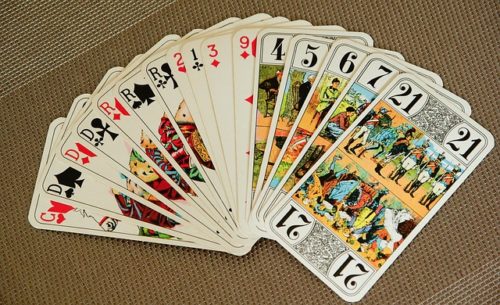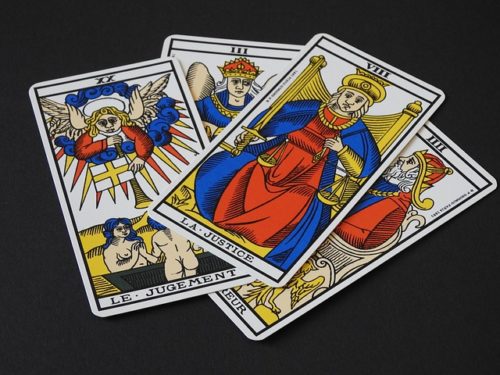![]()
The North Star Tarot Conference provided a perfect entry into the muddle that comes between the snowy depths of winter and the tentative combination of longer days mixed with occasional sights of greenery. The annual conference is sponsored by the Twin Cities Tarot Collective. Although the cards for this year’s event consisted of justice and the high priestess, the main focus centered around an exploration of justice — the card and the reality. This weekend conference was a keen reminder of how tarot cards can provide entertainment, practical insight, and a foundation of wisdom. Each is a measure how tarot calls for adjustment.
Imagine a quiet evening with a set of 78 brightly colored cards with images from a bygone era, a few friends, and lots of laughter. French Tarot, a points game normally played with four players, seemed a good place to start for something lighthearted on a Friday night. Although there were two other equally good sessions, one for an introduction to tarot for beginners and another where you could get a tarot reading, I was in the mood for something different from how I normally viewed tarot, a tool for divination, wisdom, and exploration of the self or for others.
While it was helpful to look at the five-page detailed list of instructions afterwards, the game itself lends to a sense of camaraderie among the players with a deeper understanding of how tarot cards were once used far more widely in an everyday sense. The delight in playing 78 cards that bore a slight similarity to current 52-card decks reminded me that this is a game that can be used by anyone, especially and including individuals or groups who use tarot just for divination or professional reading purposes as a means to strengthen and explore the joy in tarot. The bidding process has players hedge bets on winning a certain number of card points. What fascinated me was how much variety remained despite the restriction of not going lower than the person before you. If the first person bids medium, and you know that your hand doesn’t look good for winning, you either pass or bid large. It helps to let go of any other preconceived notions of other card games although it reminded me at times of Hearts and Bridge.

Tarot playing cards [Pixabay].
The Saturday portion of the conference was a pleasant surprise as it did not have multiple options. Instead, there were four main presentations spread over a seven-hour period with plenty of time for breaks, lunch, and a partial digestion of lessons learned. Many who arrived came with several tarot decks; collectors and tarot enthusiasts blended throughout the day.
Each of the four sessions left me wanting more in the positive sense. The morning icebreaker exercise with Nancy Antenucci delved into the unknown by using the tarot to get to know others and oneself. Often tarot booklets, guides, and teachings limit the meaning of tarot cards to a few words or images when read upright or reversed. During the exercise, it was a pleasure to see the variety of decks that included images and figures that ranged from the Renaissance period through abstract geometric orbs to self-made decks from paintings or pictures.

The generosity of those who showed the cards from a favorite deck or the one that seemed appropriate for the day transformed a simple exercise of getting to know others into a broad awakening into learning more about the self. The familiar faces of Rider-Waite style decks and the Thoth deck were present, but so were decks that encouraged artistic vision and creativity, like the Tarot of Physics. The gift of the setting of a tarot conference was the expansion of how each card is seen and understood. For each card, meeting twenty people gave twenty different possible meanings for the recipient to enjoy.
I thoroughly enjoyed Jeannette Roth’s historical and well-integrated presentation on the high priestess and justice cards. Two parts made it so delightful: the introduction with images that paired the high priestess and justice on a best friends-style road-trip and the adapted history of tarot from from the fifteenth century onward. The visual presentation of cards from various publishers throughout the centuries demonstrated the evolution from the use of tarot cards as entertainment through the introduction of decks that were used for the types of readings that are common in the 21st century. For a product that is associated with Paganism and Pagan paths, many tarot decks from early on through the present have very Christian imagery.
One debatable question that has arisen with tarot enthusiasts is whether justice should be labeled as the number eight or the number 11. The delight was how there was not condemnation of someone else for holding a different point of view. It was all subject to interpretation. One person might consider strength to be the number 11 and justice to be the number eight; others reverse that position. Spending hours looking at varieties of the same card, I still am not sure whether I prefer justice with wings or with pillars; with or without a blindfold; standing or seated; with scales balanced or uneven.

Justice [Pixabay].
After a delicious lunch, both the third session, Michael Foster’s “Tarot on the Orient Express” and the fourth session, James Wells’ workshop “Be a Priestess of Justice” expanded upon the ideas of balance and adjustment in looking at the justice card. In the Pagan community, we can struggle with how to maintain and to use justice in all forms. When is it too much and when is it too little? Foster’s session uncovered another layer to the understanding of the tarot card justice by asking about ethics. We expect others to have an ethical code of some sort, yet the specifics may be rarely discussed. Foster’s presentation left me thinking about when an otherwise horrific act, such as murder, acceptable? If we see the concept and the tarot card of justice being a right or wrong matter, then how we interpret the card in a reading and how we engage in justice in our everyday lives will vary greatly from those who see the concept of justice as flexible or adjustment. When the concept of restorative justice is considered versus a strict legal interpretation, the outcome for a given situation may be very different. Foster challenged the audience to move beyond seeing justice as a card, and to reexamine how we choose and use justice in our everyday lives.
Wells turned the focus back to the group and the individual with an extended exercise that involved both high priestess and justice cards through a series of meditations, card revelations, and group interaction. What I enjoyed was the conscious use of meditation to bring participants into the space and to help those present to leave the space. The Imbolc circle was left open from Friday night; otherwise, Wells’ presentation could very well have been a lovely ritual with opening and closing of a circle to frame the sacred space for interplay with individual gnosis. The call to explore our own experience with the high priestess and justice cards lasted well beyond the final bell signaling the end of the meditation. It influenced dinner conversation and what was covered in a craft workshop on Sunday morning.
While I did not attend the Saturday night slumber party with late-night tarot movies, the richness of the afternoon stayed with me in my own play the next morning. The choice was a craft session or learning more about the Lenormand cards. I was curious about how I could make tarot come alive even more than the previous day, and I was not disappointed.
Working in a group and using all types of stamps, ink pads, colored pens, pencils, images and word pieces, we crafted images from the numerous decks that the beauty of tarot sprawled across a long table. It reminded me of a quilting bee where each person works on one small part of the whole, or a stitch session with fellow knitters or crocheters who admire the colors, texture, and feel of the yarn being used. I now have seven decks on my wish list. Some are out of print; some are collectibles.
While the final session before the closing ritual was called a practice session, we had been practicing all weekend. By focusing on just two main cards, high priestess and justice as a start, the world of tarot widened in a spectacular way. As a witch and polytheist, tarot is a part of my life. Meeting those who are collectors or who read without having a connection to the Pagan community has left me wanting to know and to learn more from them.
At some point on Saturday, a fellow participant asked me if I was a tarot reader or a tarot collector. I don’t recall what I said at the time because tarot is a part of my religious practice. While my tarot collection has grown slightly thanks to that weekend, I would not call myself a collector at this point. When I have to find a separate cabinet or closet for my decks, then I check the box as a collector.
By the time we closed just after noon with a ritual close and distribution of certificates, I discovered a renewed interest in tarot beyond the card with a community that is nearby. A welcome respite during a long winter, North Star Tarot Conference is a welcoming and nurturing event for those new to tarot and experienced tarot enthusiasts alike. I’ve marked my calendar for next year and another exciting journey.
* * *
The views and opinions expressed by our diverse panel of columnists and guest writers represent the many diverging perspectives held within the global Pagan, Heathen and polytheist communities, but do not necessarily reflect the views of The Wild Hunt Inc. or its management.
The Wild Hunt is not responsible for links to external content.
To join a conversation on this post:
Visit our The Wild Hunt subreddit! Point your favorite browser to https://www.reddit.com/r/The_Wild_Hunt_News/, then click “JOIN”. Make sure to click the bell, too, to be notified of new articles posted to our subreddit.

Pingback: North Star Tarot Conference 2018 – Twin Cities Tarot Collective
Pingback: The Hit List - Sometimes it takes a minute, Los Angeles - The Tarot Lady